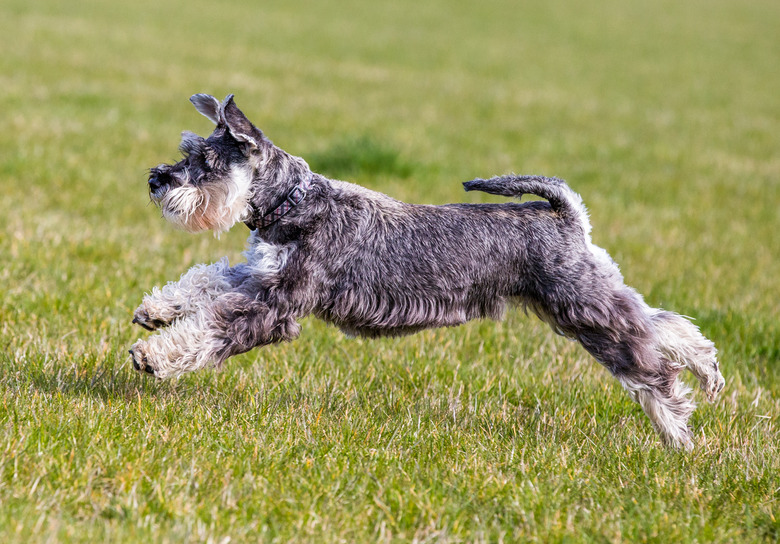Miniature Schnauzer Lifespan: How Long Do Mini Schnauzers Live?
Miniature schnauzers are easily recognized by the mustache, beard, and bushy eyebrows that give them their distinctive, almost-human appearance. Their ancestors, the larger standard schnauzers, were used as working farm dogs who pulled carts and hunted rats. Mini schnauzers inherited the curiosity, perseverance, and adaptability that help make them a favorite family pet. Generally a healthy dog, the miniature schnauzer life expectancy is between 12 and 15 years.
Identifying a mini schnauzer's color
Identifying a mini schnauzer's color
Three colors of mini schnauzers are accepted by the AKC: salt and pepper, black and silver, and solid black. The salt and pepper coloring can be dark or light, including tan, and often fades to white in the eyebrows, whiskers, cheeks, throat, ears, chest, under the tail, and possibly the underbody. In black and silver dogs, the salt and pepper areas should be solid black instead. Black dogs should have a rich, dark topcoat and a softer black undercoat. Noses are all black. Of course, miniature schnauzers that are pets and not show dogs are just as cute in any color mix.
Feeding a miniature schnauzer
Feeding a miniature schnauzer
What and how much you feed your dog can make a big difference in the health and your miniature schnauzer's lifespan. All dogs are prone to becoming overweight from eating too much, having too many treats, or eating human food in addition to their recommended diet. Overweight dogs can develop diabetes, heart disease, and orthopedic problems due to the excess weight on their bodies. This is especially true for small dogs like miniature schnauzers, who stand just 12 to 14 inches high and weigh between 13 and 15 pounds, so that even a few pounds matter.
If you want to feed your miniature schnauzer human food, most vets are in agreement as long as it makes up a maximum of 25 percent of the diet's calories. Feeding only human food is generally not recommended because there are many good dog foods that are designed for your dog's size and age, and that provide a balanced diet. If you decide to supplement with human food, be sure to research the foods dogs should never eat, like chocolate, garlic, and onions, because they can be toxic and make your dog very ill.
Miniature schnauzers are very intelligent and can be trained fairly easily. If you want to reward training accomplishments with treats, be sure to include the treats' calories in the dog's overall daily calorie count. It's easy to do this by freezing pieces of fruit such as strawberries, pineapple, and apples (just pick out the apple seeds, which are toxic to dogs).
Exercising for Maximum Health
Exercising for Maximum Health
Regular exercise is important for maintaining the miniature schnauzer's weight and overall health and helping to expand the lifespan of a schnauzer. This energetic, curious dog may get bored and frustrated easily without a change in scenery and activities, so try taking different routes when you go outside for a walk.
Play with your dog daily, inside or outside. Miniature schnauzers don't seem to have a preference for one or the other and, because they're so adaptable, they adjust quickly to city apartment living or exploring open space in the country. However, they are more playful than their larger relatives and do need their exercise. Be sure to keep your miniature schnauzer fenced in when not on a leash because their desire to hunt for prey can make them quick escape artists.
Vary their toys by putting some away for a few days, then reintroduce them. Leave some toys at floor level and others up high so that they have to work at accessing them. Miniature schnauzers cannot be left alone for long periods because they become restless and can be destructive to furniture, shoes, and rugs. Besides, they love being with their people family and are small enough to go everywhere with you.
Watching for health problems
Watching for health problems
Although a typically healthy breed, miniature schnauzers can be prone to cataracts, urinary stones, liver shunts, pancreatitis, and hyperlipidemia, which refers to excess fat in the blood, usually either triglycerides or cholesterol. Reputable breeders should have tested the dog's parents for these conditions and have the paperwork to show you. If you got your dog as a rescue, ask about its background, but your vet will probably want to test for these conditions. Catching and treating any problems early can help keep your dog healthy and increase its lifespan, so keep regular vet appointments.
Grooming for training and home
Grooming for training and home
Miniature schnauzers are popular show dogs because of their unusual faces and ability to learn quickly. They are also known for being an obedient breed, which is very helpful for training. All schnauzers have a double coat that is soft underneath and wiry on top. Show judges like to see schnauzers coats "hand-stripped," which takes time and is expensive but is not painful to the dog. It involves using special tools to remove hair that has shed but not fallen to the floor yet.
If you're not planning to show your miniature schnauzer, most owners use clippers to shear off the topcoat. A variety of tools are used due to the differences between the wiry topcoat and soft undercoat, so it may be desirable to use a professional groomer, but you can do it yourself if you receive proper training from your breeder or groomer. Miniature schnauzers do not shed much, but their coats must be brushed almost daily to keep their coats looking their best and free from matting.
References
- Animal Planet: Dog Breed Selector: Miniature Schnauzer Guide
- AKC: Miniature Schnauzer
- The American Miniature Schnauzer Club: All About Miniature Schnauzers
- AKC: Foods Dogs Can and Can't Eat
- VCA Hospitals: Hyperlipidemia
- Cuteness: Types of Schnauzers
- Cuteness: How Much Does a Miniature Schnauzer Eat?


